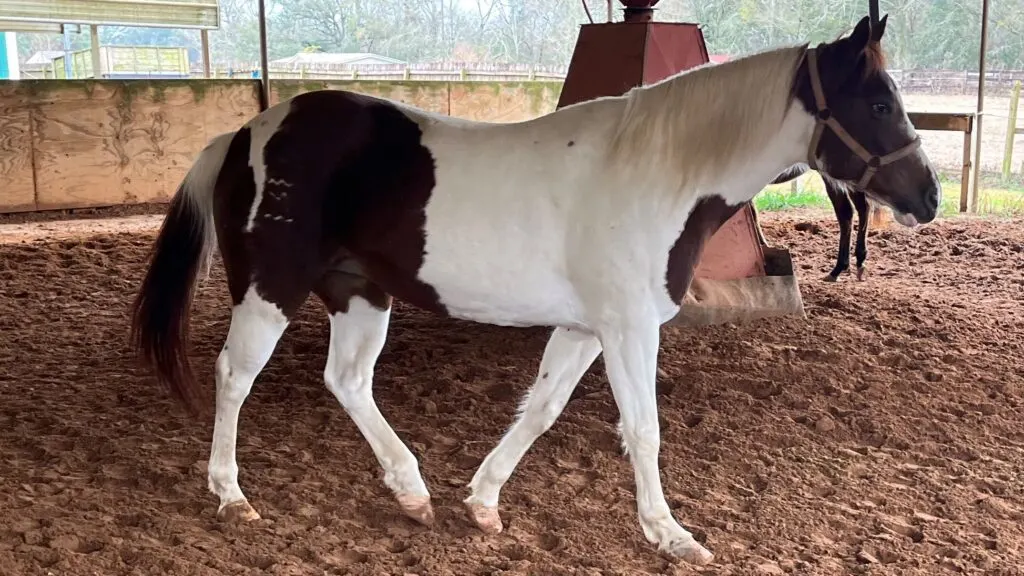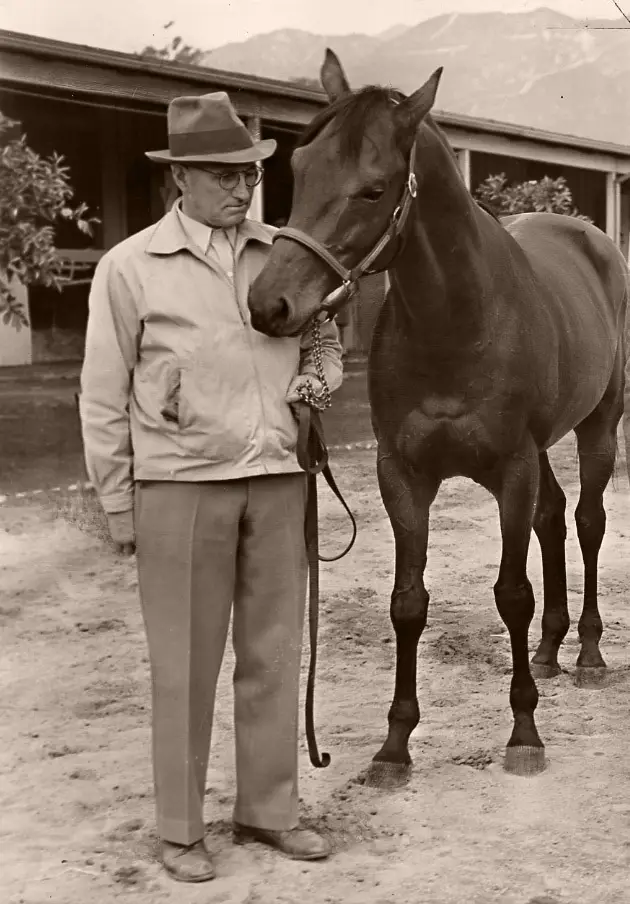Last updated: February 26, 2024
In horse racing, the success of a racehorse can be influenced by the lead horse, or ‘pony horse,’ an essential yet often overlooked figure. These horse guides play a pivotal role in maintaining the racehorse’s calmness, focus, and peak performance.
Drawing from extensive experience in horse racing, it’s clear that lead horses are more than mere companions; they are crucial for a racehorse’s preparation and success. This exploration delves into five key reasons that underscore pony horses indispensability in the racing world, highlighting the complex teamwork and strategic planning behind the scenes of this competitive sport.

5 Reasons Racehorses Need a Buddy Horse
- Calming Influence
- Racehorses are naturally high-strung. Lead horses act as calming companions, reducing anxiety and stress.
- Studies show horses are less stressed in groups. Lead horses provide this sense of herd and comfort.
- Trainers and jockeys note the immediate calming effect a lead horse has on racehorses.
- Safety on the Track
- Lead horses stabilize unpredictable racehorse behavior, ensuring safety.
- They guide racehorses amidst distractions like crowds and noise, keeping them focused.
- Their presence prevents accidents by controlling the racehorse’s path and pace.
- Guided Warm-Up
- Proper warm-up is crucial for racehorses to perform their best.
- Lead horses ensure racehorses warm up adequately without overexerting.
- This structured warm-up boosts racehorse stamina, agility, and speed.
- Training and Familiarization
- Lead horses mentor young and inexperienced racehorses, teaching them the ropes safely.
- They help acclimatize racehorses to the sensory overload of the racetrack.
- During rehearsal runs, they simulate race conditions, preparing racehorses for actual races.
- Post-Race Cool Down
- Essential for transitioning from high energy to rest, lead horses aid in gradual cool-down.
- They help manage post-race stress, ensuring a smooth transition for the racehorse.
- This contributes to the racehorse’s immediate recovery and long-term health.

Origins and Evolution of Pony Horses in Racing
Initially, pony horses provided a steadying presence for high-spirited racehorses. Their role has expanded to include guiding, calming, and accompanying racehorses, becoming a pre-race ritual. Modern practices select pony horses for their ability to bond, maintaining tradition while evolving with the sport.
Tradition vs. Innovation in Horse Racing
- Horse racing balances tradition with modern advances, respecting historical practices while embracing innovation.
- The use of pony horses is a testament to this balance, combining time-honored methods with contemporary approaches.
Defining a Buddy Horse
- Lead horses, or pony horses, guide and calm racehorses, ensuring smooth and safe racing events.
- They are characterized by their calm demeanor, experience, and trustworthiness, contrasting with the high-spirited nature of racehorses.
- While racehorses focus on speed and agility, lead horses are valued for their obedience and adaptability, often serving longer on the track due to their guiding role.

The Bond Between Racehorses and Pony Horses
Stories abound of deep bonds between racehorses and their lead horses, highlighting relationships built on trust and companionship. Examples include a famous racehorse calming only in the presence of its lead horse and a retired racehorse showing distress until reunited with its lead companion.
Long-Term Partnerships
These relationships often extend over years, providing racehorses with stability and familiarity amidst the racing world’s unpredictability. The lead horse also benefits, finding purpose in its role and companionship with its racehorse partner.
Role of Riders and Handlers
The bond between racehorse and lead horse is carefully nurtured by riders and handlers. They facilitate comfort and familiarity through joint training sessions and shared resting spaces, understanding and catering to each horse’s unique temperament and needs.
Pony horses are ridden with a western saddle.
A western seat allows a rider more maneuverability and stability while on the companion horse. While riding a pony horse, a rider will need to perform tasks more similar to a western horseback rider than a racer or jumper.

Popular Breeds for Pony Horses
Quarter horses and thoroughbreds are the most common pony horse breeds on racetracks, often chosen for their racing background. Retired racehorses, particularly geldings, are preferred for their calmer demeanor compared to stallions and mares.
Quarter Horses as Pony Horses
- Known for their level-headedness, good conformation, athleticism, and desire to please, quarter horses are excellent pony horses.
- Their quickness and agility make them suitable for the role.
Thoroughbreds in the Role
- Thoroughbred geldings are often transitioned into pony horses, despite the breed generally being less calm and sound than quarter horses.
Draft Crosses
- Valued for their large size and calm nature, draft crosses are effective pony horses at racetracks.
- Their only drawback is potentially lacking quickness to chase a breakaway horse, though the right crossbreed can mitigate this issue.
Grade Horses
- Grade horses, with their varied breed mix, frequently serve as companion horses, often excelling as pony horses due to their adaptable qualities.
Why Geldings?
- Geldings are favored for their calmness and familiarity with trainers and riders, making them ideal companion horses.

Pony horses and companion horses aren’t the same.
A lot of people use the terms pony horse and companion horse interchangeably, and that’s okay. But technically, a companion horse, or companion animal, is an animal kept with a racehorse to keep the horse calm.
The companion horse differs from a pony horse in that a companion horse will stay with one particular horse most of the time. It’s not uncommon for a companion horse to work double duty as a pony horse.
Some great racehorses had companion animals.
Seabiscuit had companion animals.
Horses are herd animals and enjoy the companionship of animals. Seabiscuit is famously housed with a group of animals. Kentucky Derby winners Unbridled and Smarty Jones had companion horses.

Butterscotch was both a companion and a pony horse.
Smarty Jones’ companion Butterscotch filled two roles, babysitter and pony horse for him. Smarty Jones won the 2004 Kentucky Derby and Preakness Stakes and placed in the Belmont Stakes, with Butterscotch leading him to each race’s starting gates.
The two horses bonded, and Smarty and Butterscotch almost won the triple crown.
American Pharoah had a companion horse.
American Pharoah had a companion horse, a 6-year-old gelding named Smokey. Smokey helped calm American Pharoah’s nerves enough for him to win the Triple Crown.
Thoroughbred horses are high, strung animals. They are removed from their natural state and placed into stalls, leading to boredom and stress.
Having a companion animal helps to fill a void in their lives. A happy or content horse can endure the rigors of racing better than a depressed horse. Companion animals have their place in horse racing.
Interesting info:
- Europeans, as well as some other countries, don’t use pony horses in horseracing.
- Pony riders are required to wear protective helmets and vests while riding on a track.
Here’s a YouTube video about racehorse companions.
Conclusion
In the grand spectacle of horse racing, it’s easy to focus solely on the racehorses as they thunder down the track. However, behind every successful racehorse is a lead horse, diligently guiding, calming, and supporting. From ensuring safety and performance enhancements to forging deep emotional bonds, these lead horses are truly the backbone of the racing world.
Next time you’re at the racetrack or tuning in from home, take a moment to acknowledge the quiet contributors. The lead horses might not bask in the limelight, but their impact is undeniable. Let’s raise a toast to these unsung heroes who, in their unique way, make every race possible and every victory sweeter.
Stay Connected and Informed:
- If you found this guide helpful, consider signing up for our newsletter for more insights and updates on racehorse ownership.
- For personalized advice or specific inquiries, feel free to contact me directly. I’m here to help guide you through your racehorse ownership journey.
Connect with Me
- Email: [email protected]
- Social Media: Follow me on Facebook for daily updates, tips, and insights into the world of horses.
- Website: Visit my website horseracingsense.com, for more articles, resources, and information about my work.
Join the Conversation:
- I encourage you to share your thoughts, experiences, or questions in the comments section below. Let’s create a community of informed and passionate racehorse owners.
- Don’t forget to share this article with your network. Use the social share buttons to spread the knowledge and love for racehorse ownership.
Thank you for reading, and I look forward to connecting with you, whether it’s through our newsletter, direct communication, or in the comments section. Here’s to the thrilling journey of racehorse ownership!
Meet Miles Henry
An avid equestrian and seasoned racehorse owner, Miles Henry brings his extensive experience to the equine world, proudly associating with the AQHA, The Jockey Club, and various other equine organizations. Beyond the racetrack, Miles is an accomplished author, having published various books about horses, and is a recognized authority in the field, with his work cited in multiple publications.
🔗 Connect with Miles:
Twitter
Facebook
YouTube: Check out race highlights, horse care tips, and more!

